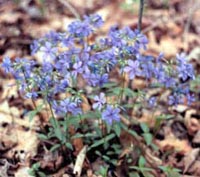Resource Library
Plant of the Week: William, Wild Sweet
The University of Arkansas System Division of Agriculture does not promote, support or recommend plants featured in "Plant of the Week." Please consult your local Extension office for plants suitable for your region.
Plant of the Week
Wild Sweet William
Latin: Phlox divaricata

Shade is both a blessing and a curse to the gardener. Because gardeners are not immune
to the heat of the summer sun, shade makes any garden more pleasant to be but it limits
the choice of plants that can be successfully grown. Especially lacking are flowering
perennial plants that give good display and yet thrive in the shade. The Wild Sweet
William, one of our native woodland phloxes, not only grows naturally in the shade
but produces a beautiful display without much fuss or bother for the gardener.
Wild Sweet William, so called because it blooms at about the same time as the commonly
cultivated Sweet William, flowers from early April through mid-May. Plants are pubescent,
much branched and grow from 10- to 16 inches tall on slender stems.
Flowers are tubular, with the face to 1 inch across, lavender-purple in color and
produced in a terminal cluster. White and pink forms are occasionally met with in
the wild. The plant growth habit is intermediate between the sprawling form of creeping
phlox and the stiffly erect form of the summer flowering garden phlox. This species
ranges from southern Canada to Michigan and as far south as Louisiana and Georgia
and is found in the woods throughout Arkansas.
The 60 species of phloxes are all native to North America and were quickly recognized
as valuable garden plants by early European plant explorers. Wild Sweet William never
hit the big time status of the summer flowering garden phlox but its popularity as
a garden plant in Europe has always been higher than here at home. It is ideal for
the woodland garden or even shady border where an early spring display is needed.
Wild Sweet William is best in partial shade, but like most part shade plants, will
grow in the sun if it gets some water in the summer. A good way of deciding how much
shade exists in a proposed site is to look at what kind of lawn grass will grow there.
Bermudagrass is a full sun plant that will grow up to the edge of shade and stop.
It requires at least six hours of full sun to grow. Fescue is a grass that will grow
in partial shade -- admittedly it produces a better lawn in full sun -- but it will
still grow in some shade. The shade can be dappled shade from the crown of high trees
or full shade for part of the day and full sun for part of the day, but usually only
a few hours. If the site is so shady that no grass species will grow, then the site
has heavy shade. Fortunately Wild Sweet William is adaptable enough it will grow in
heavy shade too.
This species is best suited to a rich woodland soil where there is a high amount
of organic matter and good drainage. It will tolerate periods of drought but performs
best if given some water during the dry periods. In the right spot it will reseed
and increase the size of the colony but usually garden plants are rooted from cuttings
taken in the summer. Its open and natural form makes it ideal for use as a single
specimen or in large drifts of color to brighten the dark recesses of the spring garden.
By: Gerald Klingaman, retired
Extension Horticulturist - Ornamentals
Extension News - April 16, 1999
The University of Arkansas System Division of Agriculture does not maintain lists of retail outlets where these plants can be purchased. Please check your local nursery or other retail outlets to ask about the availability of these plants for your growing area.